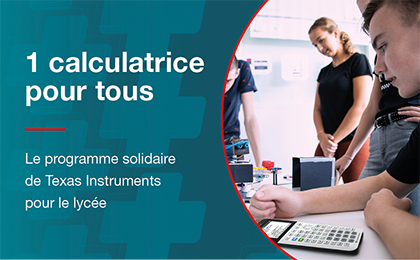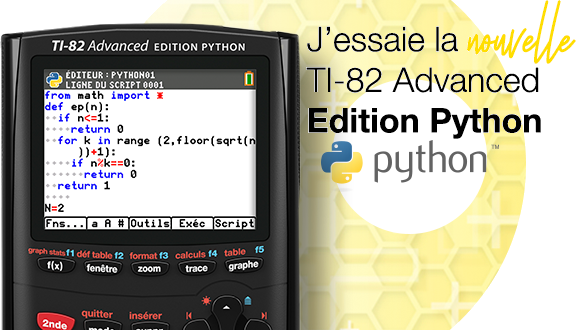Choisir sa calculatrice :
Tableau de comparaison (QCC 2024)
Analyse/Guide complet (QCC 2024)
Tutos mode examen :
Candidats : Activation • Liste modèles conformes
Surveillants : Lancement épreuves • Revalidation
Welcome to TI-Planet, the reference scientific and graphing calculators community !
Grand Concours 2024-2025 - Programmation Python !
-
Facebook Instagram X/Twitter YouTube Discord
Social TI-Planet
-
Donations / Premium
For more contests, prizes, reviews, helping us pay the server and domains...
Donate
Discover the the advantages of a donor account !
JoinRejoignez the donors and/or premium!les donateurs et/ou premium !
Donate
Discover the the advantages of a donor account !
JoinRejoignez the donors and/or premium!les donateurs et/ou premium !
-
Stats.
746 utilisateurs:
>722 invités
>17 membres
>7 robots
>722 invités
>17 membres
>7 robots
Record simultané (sur 6 mois):
6892 utilisateurs (le 07/06/2017)
6892 utilisateurs (le 07/06/2017)
News
- Catégories
- TI-Nspire
- TI-82 / 83 / 84
- TI-89 / 92 / Voyage 200
- TI Scientifiques
- Casio
- NumWorks
- HP
- Symbolibre, Librecalc
- Lexibook, Truly
- Zero
- Examens - Concours
- Divers
- All news
- Latest news
- Luz Rello, nouvelle Women Do Science 2025 par Casio Espagne43
[Casio] (18/02 15:53) - Disparition de Romain Liévin, pilier de la communauté TI375
[Divers] (16/02 19:29) - TI ExamCalc complété avec les TI-Nspire CX II214
[TI-Nspire] (12/02 22:56) - 4 nouvelles Women Do Science 2025 sur coques Casio !169
[Casio] (12/02 21:16) - SDL Tetris, 1ère appli adaptée pour Graph Math+/fx-CG100294
[Casio] (09/02 21:39) - MPM bêta, lanceur application .g3a pour Graph Math+ fx-CG1001046
[Casio] (09/02 17:42) - Extension Women Do Science avec Hypatie sur Graph Math+336
[Casio] (06/02 12:11) - Nouvelle coque Marie Curie pour Graph Light220
[Casio] (06/02 10:33) - Nouvelle coque Sophie Germain pour fx-92 Collège Classwiz237
[Casio] (06/02 10:07) - Mise à jour HP Prime 2.3.1.15270 défectueuse par Moravia791
[HP] (05/02 11:59)
Programs &
Downloads
- Downloads
- TI-Nspire
- TI-83 Premium CE / 84+CE / 82APy
- TI-82 Advanced / 84+T
- TI-82+ / 83+ / 84+
- TI-76.fr / 82 Stats / 83
- TI-89 / 92 / Voyage 200
- NumWorks
- Casio Graph 25 35 75 85 95
fx-7400/9750/9860 G/GII/GIII - Graph Math+/90+E - fx-CG10/20/50
- Casio fx-CP400/CG500
- HP Prime
- 39gII
- 49/50
- 48
- Selections (Exams, tools, lessons...)
- Upload a file
- My uploaded files
- Latest files
-
Cahier d'activités Women Do Science
6
[Tutoriaux Casio Graph 25+/35+/75/85/95 USB] (Casio) -
Juste prix
4
[Jeux TI-83 Premium CE / 84+CE / 82APy] (Ranaca (Raphael Nachtegaele)) -
SDL Tetris
18
[Jeux Casio Graph Math+/90+E/fx-CG] (SlyVTT) -
MPM 1.0
15
[Utilitaires Casio Graph Math+/90+E/fx-CG] (Planète Casio) -
War
20
[Jeux NumWorks] (Aubinouchouchou) - Latest updates
-
First Fantasy: Mana Force v5.3.1
1727
[Jeux TI-83 Premium CE / 84+CE / 82APy] (DJ Omnimaga) -
Plateforme
10
[Jeux NumWorks] (dkfe123) -
Flappy Bird
126
[Jeux NumWorks] (Aubinouchouchou) -
Space Invader
1054
[Jeux NumWorks] (Gugus_BSS)
- Popular files
-
Oiram CE (mario-like)
873
[Jeux TI-83 Premium CE / 84+CE / 82APy] (MateoConLechuga) -
Geometry Dash CE
763
[Jeux TI-83 Premium CE / 84+CE / 82APy] (Epharius) -
PacMan CE
601
[Jeux TI-83 Premium CE / 84+CE / 82APy] (MateoConLechuga) -
Flappy bird color
561
[Jeux Casio Graph Math+/90+E/fx-CG] (Lancelot) -
Mario Kart CE
538
[Jeux TI-83 Premium CE / 84+CE / 82APy] (tr1p1ea) -
CGDoom fx-CG50 / Graph 90+E
478
[Jeux Casio Graph Math+/90+E/fx-CG] (Lephenixnoir) -
FlappyBird
472
[Jeux TI-83 Premium CE / 84+CE / 82APy] (Rico) -
Doom (Shareware)
418
[Jeux Doom Casio Graph Math+/90+E/fx-CG] (Id Software) -
Snake
364
[Jeux NumWorks] (Golem64) -
Donkey Kong CE
314
[Jeux TI-83 Premium CE / 84+CE / 82APy] (Rico)
Converters
- Latest converted documents
- CMAT 3456
[mViewer GX Creator Prog HP-Prime] (enriquecarrions) - CMAT 3456
[mViewer GX Creator Lua TI-Nspire] (enriquecarrions) - controladores
[mViewer GX Creator App HP-Prime] (pandoramdrs) - Questões Mod
[mViewer GX Creator App HP-Prime] (cezar17) - Questões Mod
[mViewer GX Creator App HP-Prime] (cezar17) - Resumen formulas F2
[mViewer GX Creator Lua TI-Nspire] (kluci) - Resoluções
[mViewer GX Creator Lua TI-Nspire] (cezar17) - Questões
[mViewer GX Creator Lua TI-Nspire] (cezar17) - Questões
[mViewer GX Creator App HP-Prime] (cezar17) - 1erEFC024
[mViewer GX Creator App HP-Prime] (jimmy montania)
Forum
- Catégories
- TI-Nspire
- TI-82 / 83 / 84
- TI-89 / 92 / Voyage 200
- TI Scientifiques
- Casio
- NumWorks
- HP
- Divers
- Quick links
- All forums
- Topics of the last 7 days
- Unanswered messages
- Unread messages
- Messages since last visit
- Latest posts
- Luz Rello, nouvelle Women Do Science 2025 par Casio Espagne43
critor (18/02/2025 15:53) - Re: pdf doesn’t fully load through ndless12138
arnaudfpm (17/02/2025 19:08) - Disparition de Romain Liévin, pilier de la communauté TI375
critor (16/02/2025 19:29) - Re: Concours Python 2024-2025 - Championnat de codage jeu vi9156
critor (15/02/2025 21:29) - Re: Suites récurrentes sur tn spire cx cas633
Adriweb (15/02/2025 17:07) - Re: Mise à jour Graph Math+ 2.00 avec 9 nouvelles applicati2385
parisse (15/02/2025 13:39) - Re: MPM bêta, lanceur application .g3a pour Graph Math+ fx-C1046
parisse (14/02/2025 15:38) - Re: Coloration syntaxique HP Prime216
critor (13/02/2025 13:15) - TI ExamCalc complété avec les TI-Nspire CX II214
critor (12/02/2025 22:56) - 4 nouvelles Women Do Science 2025 sur coques Casio !169
critor (12/02/2025 21:16)
Gallery
- Latest picture
-
Graph Math+ & SDL_Tetris
[Généralités Casio]
© 2011-2025 TI-Planet.
Website managed by UPECS non-profit organization. See our privacy policy.
The proper functioning of TI-Planet relies on cookies. You can configure (and consent to) the usage of optional cookies.
SmartNav : Off (ON = connexion nécessaireON = login required)
Nous ne pouvons pas forcément surveiller l'intégralité du contenu publié par nos membres - n'hésitez pas à nous contacter si besoinWe may not be able to review all the content published by our members - do not hesitate to contact us if needed (info[at]tiplanet[.]org).
Forum powered by phpBB © phpBB Group — Traduction phpBB par phpBB-fr — Some icons from FatCow
The proper functioning of TI-Planet relies on cookies. You can configure (and consent to) the usage of optional cookies.
SmartNav : Off (ON = connexion nécessaireON = login required)
Nous ne pouvons pas forcément surveiller l'intégralité du contenu publié par nos membres - n'hésitez pas à nous contacter si besoinWe may not be able to review all the content published by our members - do not hesitate to contact us if needed (info[at]tiplanet[.]org).
Forum powered by phpBB © phpBB Group — Traduction phpBB par phpBB-fr — Some icons from FatCow













